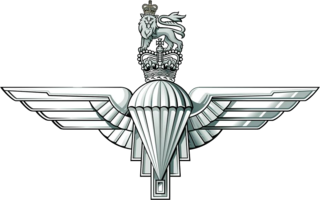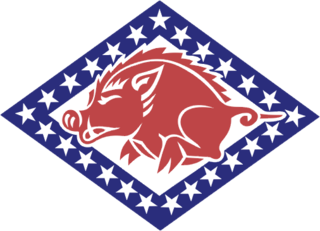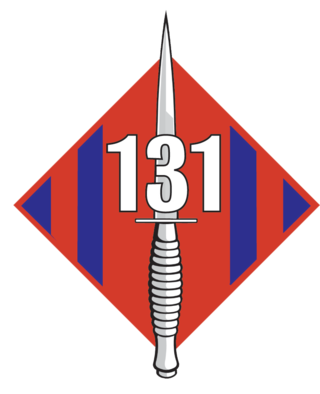
The 82nd Airborne Division is an airborne infantry division of the United States Army specializing in parachute assault operations into hostile areas with a U.S. Department of Defense mandate to be "on-call to fight any time, anywhere" at "the knife's edge of technology and readiness." Primarily based at Fort Liberty, North Carolina, the 82nd Airborne Division is part of the XVIII Airborne Corps. The 82nd Airborne Division is the U.S. Army's most strategically mobile division.

The 1st Infantry Division (1ID) is a combined arms division of the United States Army, and is the oldest continuously serving division in the Regular Army. It has seen continuous service since its organization in 1917 during World War I. It was officially nicknamed "The Big Red One" after its shoulder patch and is also nicknamed "The Fighting First". The division has also received troop monikers of "The Big Dead One" and "The Bloody First" as puns on the respective officially sanctioned nicknames. It is currently based at Fort Riley, Kansas.

The Parachute Regiment, known colloquially as the Paras, is the airborne and elite infantry regiment of the British Army. The first battalion is part of the Special Forces Support Group under the operational command of the Director Special Forces. The other battalions are the parachute infantry component of the British Army's rapid response formation, 16 Air Assault Brigade. Alongside the five regiments of Foot Guards, the Parachute Regiment is the only infantry regiment of the British Army that has not been amalgamated with another unit since the end of the Second World War.

The Battle of Mount Longdon was fought between the British 3rd Battalion, Parachute Regiment and elements of the Argentine 7th Infantry Regiment on 11–12 June 1982, towards the end of the Falklands War. It was one of three engagements in a Brigade-size operation that night, along with the Battle of Mount Harriet and the Battle of Two Sisters. A mixture of hand-to-hand fighting and ranged combat resulted in the British occupying this key position around the Argentine garrison at Port Stanley. The battle ended in a British victory.

The company sergeant major (CSM) is the senior non-commissioned soldier of a company in the armies of many Commonwealth countries, responsible for administration, standards and discipline. In combat, their prime responsibility is the supply of ammunition to the company. They also oversee the distribution of other supplies, such as water or food, although that responsibility is mainly that of the company quartermaster sergeant (CQMS), and evacuating the wounded and collecting prisoners of war.

Ian John McKay, VC was a British Army soldier and a posthumous recipient of the Victoria Cross, the highest award for gallantry in the face of the enemy that can be awarded to British and Commonwealth forces.

The Parachute Regiment is an airborne and special forces regiment of the Indian Army. It was raised in 1945 as part of the British Indian Army but was disbanded after World War II and was re-raised in 1952 as part of the Indian Army. Currently it consists of fifteen Special Forces, two Territorial Army and one Rashtriya Rifles battalions.

The 3rd Battalion, Royal Australian Regiment is the armoured infantry battalion of the Australian Army, based in Kapyong Lines, Townsville as part of the 3rd Brigade. 3 RAR traces its lineage to 1945 and has seen operational service in Japan, Korea, Malaya, Borneo, South Vietnam, Rifle Company Butterworth, East Timor, the Solomon Islands, Afghanistan, and Iraq.

The United Kingdom was one of the first countries to take part in Operation Enduring Freedom against the Taliban regime in autumn 2001.

The Arkansas Army National Guard (ARARNG) is a component of the Arkansas National Guard and the United States National Guard. National coordination of various state National Guard units are maintained through the National Guard Bureau.

562 Parachute Squadron Royal Corps of Transport (Volunteers) was a minor unit that supported 44th Parachute Brigade (V).

9 Parachute Squadron RE is an airborne squadron of the British Army's Corps of Royal Engineers. It is part of 23 Parachute Engineer Regiment based at Rock Barracks in Woodbridge, Suffolk, and provides close engineer support to 16 Air Assault Brigade Combat Team. It traces its heritage to the first Soldier Artificer Company raised in Gibraltar in 1772. The squadron remains the longest continually serving in-role fighting unit in Airborne Forces.
Sergeant Jonathan Stuart Hollingsworth was a British Army soldier. Described as "an SAS hero" by a British tabloid newspaper, he reportedly sustained gunshot wounds during a raid to capture terror leaders in Basra and later died of his injuries at a nearby military hospital.

The 15th Indian Division was an infantry division of the British Indian Army that saw active service in the First World War. It served in the Mesopotamian campaign on the Euphrates Front throughout its existence. It did not serve in the Second World War, but was reformed at Dehradun in 1964 as part of the post-independence Indian Army.

131 Commando Squadron Royal Engineers is an Army Reserve unit and part of 24 Commando Regiment Royal Engineers. It provides engineering support to UK Commando Force. and is the largest Army Reserve Commando unit. The squadron has deployed worldwide to provide combat engineer support to the UKCF, often deploying in small sub-units. 131 was first raised in 1947 as an airborne engineer regiment, and reached a strength of over 1,000 trained parachute engineers by the early 1960s. Between 1 April 1978 and 1 October 2015, the unit was an independent Commando squadron under operational command of HQ 3 Cdo Bde RM. On 2 October 2015, it formally became the third squadron of 24 Commando Engineer Regiment.

The 173rd Airborne Brigade is an airborne infantry brigade combat team (IBCT) of the United States Army based in Vicenza, Italy. It is the United States European Command's conventional airborne strategic response force for Europe.

299 Parachute Squadron, Royal Engineers is a specialist field engineer squadron of the British Army's Corps of Royal Engineers and the only reserve parachute unit of the corps. Formed in 1947 as an airborne field squadron, 299 Para Sqn would see many reorganisations and new roles, until 2006 when it took on the parachute role it maintains today. As of 2021, it is the only reserve parachute-trained squadron of the Royal Engineers.

Brian Faulkner DCM is a former soldier of the Parachute Regiment in the British Army and a veteran of the Falklands War during which he was awarded the Distinguished Conduct Medal (DCM) for bravery. This was a field award for other ranks of the British Army and was the oldest British award for gallantry, at that time ranking second only to the Victoria Cross. His DCM was one of only eight awarded during the conflict, five of which were awarded to the Parachute Regiment. Faulkner is a member of The Gallantry Medallists' League of the United Kingdom. He received his medal from Queen Elizabeth II during an investiture ceremony at Buckingham Palace in 1982.
















